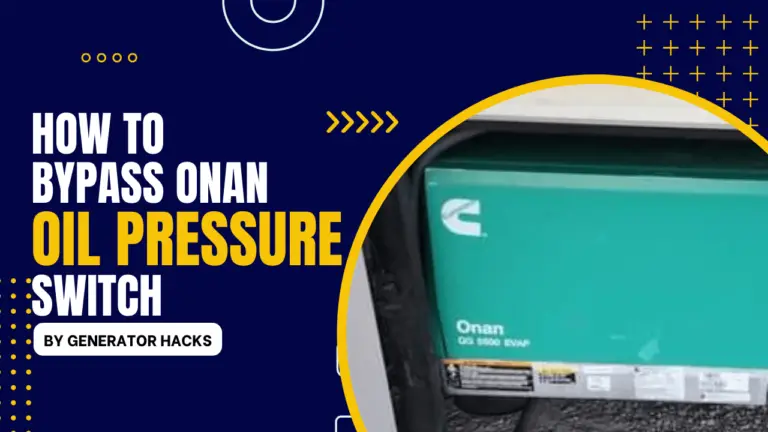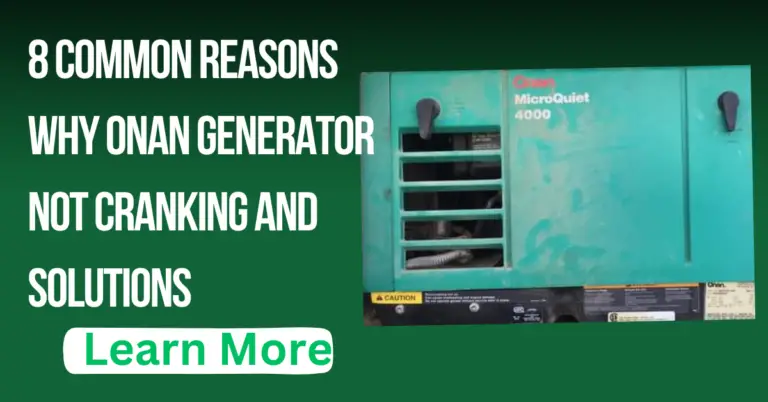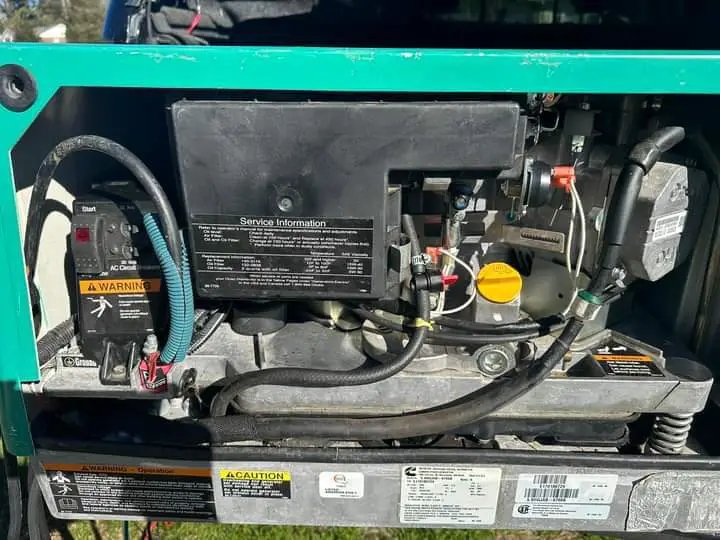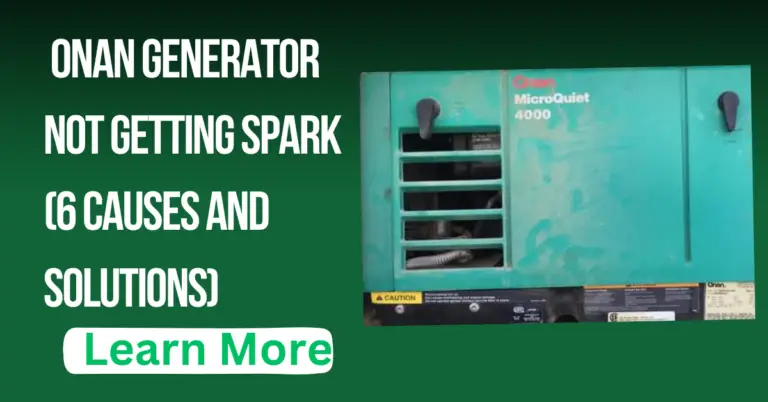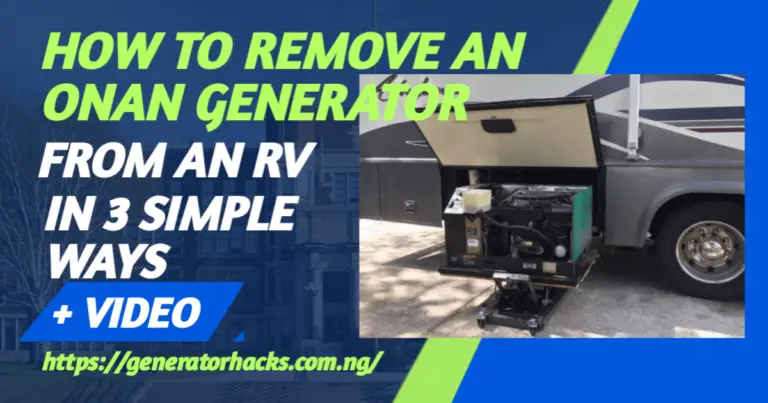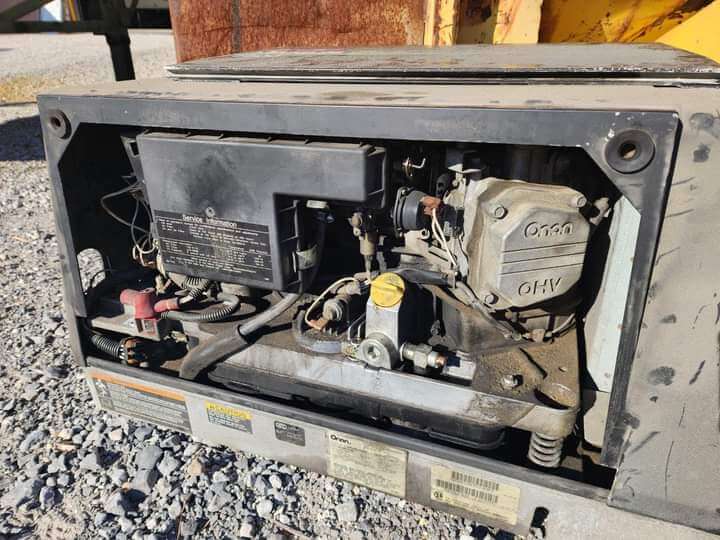As an Amazon Associate, we earn from qualifying purchases. This does not affect the price you pay or the quality of the products you buy. For more information, please read the full affiliate disclosure here.
Imagine being in the middle of a camping trip or experiencing a power outage at home, and you desperately need your trusty Onan generator to kick into action. However, much to your dismay, it refuses to start. This can be frustrating and confusing.
Onan generators refusing not to start may be due to various reasons, such as insufficient fuel, a dead battery, clogged fuel lines, or ignition system malfunctions.
Hence, in this blog post, we’ll further explain the causes behind your Onan generator’s failure to start and provide you with practical solutions to get it up and running again.
A General Overview of Onan Generators
Onan generators are renowned for their reliability and performance, making them a popular choice for various applications, including recreational vehicles (RVs), boats, and backup power solutions for homes and businesses. When it comes to troubleshooting why your generator won’t start, you must understand the basics of Onan generators.
An Onan generator is a compact, portable power source that operates on gasoline, diesel, or propane. It consists of an engine, alternator, fuel system, ignition system, and control panel. These generators are designed to provide electricity when the main power supply is unavailable or unreliable.
One of the key features of Onan generators is their ability to produce high-quality power with stable voltage and frequency. This clean power ensures the safe and efficient operation of sensitive electronic devices, such as laptops, televisions, and medical equipment.
Additionally, one of the things that keeps a generator running smoothly is regular maintenance. It entails periodic oil changes, filter replacements, spark plug inspections, and overall system checks. With all listed, you can prevent many common issues and ensure that your generator is always ready to start when needed.
Also Read:- Onan Generator Only Runs When Holding the Start Button: Causes, Solutions, and Troubleshooting Guide
Common Causes of Onan Generator Failure to Start
1. Fuel-Related Issues
Fuel is the lifeblood of any internal combustion engine, including Onan generators. Several fuel-related issues can prevent an Onan generator from starting. Among these include:
1. Insufficient fuel level.
2. Stale fuel.
3. Fuel contamination.
4. Clogged fuel lines or filters.
To address these fuel-related issues and get your Onan generator running smoothly again, here are some recommended solutions:
- Ensure the fuel tank has a sufficient amount of fresh fuel.
- If the fuel is stale, drain the tank and refill it with fresh fuel.
- Inspect the fuel for any signs of contamination, such as water or debris. If present, drain the tank and clean it thoroughly before refilling.
- Clean or replace clogged fuel filters to ensure proper fuel flow.
- Check the fuel lines for any blockages or damage. Clean or replace them as necessary.
- Lastly, consider using fuel stabilizers when storing the generator for extended periods to prevent fuel deterioration.
Also Read:- Generator Won’t Start After Running Out of Gas Here’s What to Do
2. Battery-Related Problems
Battery-related problems can also cause your Onan generator not to start when needed. And to fix it, you need to know the causes and diagnose it. The causes of battery problems include:
1. Dead or discharged battery.
2. Faulty battery connections.
3. Corroded terminals.
To address these battery-related issues and get your Onan generator up and running, here are things you can do:
- Ensure the battery is fully charged. If it’s discharged, recharge it using an appropriate battery charger or jump-start the generator using another power source.
- Inspect the battery connections for tightness and cleanliness. Clean any corrosion or debris from the battery terminals and cable connectors. Use a wire brush or a terminal cleaner for this purpose.
- If the battery connections are damaged or corroded beyond repair, consider replacing them with new connectors or cables.
- Regularly maintain and recharge the battery, especially during long periods of inactivity, to prevent it from draining or becoming completely discharged.
3. Ignition System Issues
The ignition system is one of the most important parts of any generator, and if it malfunctions, there’s no way the generator can start. So with that, here are the common issues of the ignition system that can hinder the starting process of an Onan generator.
1. Spark plug issues.
2. Faulty ignition coil.
3. Ignition switch problems.
To address these ignition system malfunctions, you can consider the following solutions:
- Inspect the spark plugs regularly and clean or replace them as needed.
- Ensure proper spark plug gap and torque specifications according to the manufacturer’s guidelines.
- If spark plugs are severely worn or damaged, replace them with new ones.
- Consult a professional for diagnostic testing if you suspect a faulty ignition coil and consider replacing it if necessary.
- Inspect the ignition switch for any damage or misalignment. Repair or replace the ignition switch as needed.
4. Low oil Level or Pressure
Proper oil levels and oil pressure is important for the optimal operation and longevity of Onan generators. Insufficient oil level or low oil pressure can have a significant impact on the generator’s starting process.
If the oil level in the generator’s engine is below the recommended range, it can cause starting difficulties. Insufficient oil volume may prevent the engine’s internal components from receiving proper lubrication, leading to increased friction and potential damage.
Some modern generators have built-in safety features that prevent the engine from starting or shutting down automatically if the oil level is too low to protect the engine from harm.
In addition to oil volume, oil pressure is equally important. Low oil pressure can indicate a problem with the oil pump or a leak in the system. Insufficient oil pressure can prevent the engine’s moving parts from receiving adequate lubrication, leading to increased friction and potential damage.
Onan generators are also equipped with oil pressure sensors that can trigger safety measures, such as preventing the engine from starting or shutting it down to prevent further damage.
5. Overloading
Overloading refers to a situation where an electrical load exceeds the maximum capacity of the generator. Overloading can lead to various issues, including the generator’s inability to start because it causes excessive electrical load on the generator, the strain on the engine, and also insufficient power generation.
To prevent overloading and ensure the successful starting of an Onan generator, consider the following guidelines:
- Determine power requirements.
- Prioritize essential loads.
- Implement load management techniques such as staggering the start-up of appliances or using separate circuits to distribute the load evenly.
- Lastly, If you constantly find yourself needing to operate a high load that exceeds the capacity of your current generator, consider upgrading to a higher-rated generator that can handle the increased power demand more effectively.
Step-by-Step Guide to Completely Troubleshoot and Fix Onan Generator Not Starting Problems
Step 1: The Pre-troubleshooting Steps
Before diving into specific troubleshooting steps, you must follow some pre-troubleshooting procedures to ensure safety and eliminate any simple issues that may be causing the Onan generator not to start.
Safety should always be a top priority when dealing with generators. Before attempting any troubleshooting, make sure to follow these safety precautions:
- Turn off all electrical loads connected to the generator.
- Disconnect the generator from the power source or utility grid.
- Allow the generator to cool down before performing any maintenance or troubleshooting.
- Wear appropriate personal protective equipment (PPE), such as gloves and safety glasses, when handling the generator or conducting any repairs.
Step 2: Refuel and Replace Stale or Contaminated Fuel
If the generator has been sitting idle for an extended period or if you suspect the fuel is old or contaminated, refueling with fresh fuel can often resolve starting problems. Drain the old fuel from the tank and replace it with clean, high-quality fuel suitable for your generator.
Step 3: Clean or Replace Clogged Fuel Lines or Filters
Clogged fuel lines or filters can restrict fuel flow to the engine, leading to starting issues. Inspect the fuel lines for any blockages, debris, or signs of damage. Clean or replace any clogged fuel filters, ensuring they are free from contaminants. This allows for proper fuel delivery and can help restore the generator’s starting functionality.
Step 4: Recharge or Replace the Battery
If the generator’s battery is dead or discharged, it may not have enough power to start the engine. Recharge the battery using an appropriate battery charger or consider replacing it if it no longer holds a charge. Ensure that the battery connections are clean, tight, and free from corrosion, as poor connections can also prevent the generator from starting.
Step 5: Clean or Replace Spark Plugs
Fouled or worn-out spark plugs can cause ignition problems, leading to difficulty in starting the generator. Remove the spark plugs and inspect them for any signs of fouling, such as carbon buildup. Clean the spark plugs using a wire brush or replace them if necessary.
Step 6: Repair or Replace Faulty Ignition Components
Faulty ignition components, such as the ignition coil or ignition switch, can prevent the generator from starting. Test the ignition coil for proper spark output using a spark tester or multimeter. If the ignition coil is faulty, replace it. Inspect the ignition switch for any damage or wear and repair or replace it as needed.
Step 7: Maintain Proper Oil Levels and Pressure
Low oil levels or insufficient oil pressure can trigger safety features that prevent the generator from starting. Check the oil levels using the dipstick and add oil as necessary to bring it within the recommended range. Monitor any oil pressure indicators or warning lights during startup.
Step 8: Redistribute the Load or Resetting After Overload
If the generator has been overloaded, it may have shut down as a safety measure. In such cases, redistribute the load by disconnecting non-essential appliances or equipment to reduce the overall power demand. After addressing the overload, allow the generator to cool down and reset before attempting to start it again.
Seek Professional Help
While some generator issues can be resolved through basic troubleshooting and DIY repairs, there are instances when it is advisable to seek professional help.
Professional servicing and repairs can provide numerous benefits and ensure the optimal performance and longevity of your Onan generator.
You can visit the official Onan or Cummins website and look for a service locator or authorized service center finder. Enter your location details to find the nearest authorized service centers in your area or ask for recommendations from friends and family around.
Final Thought
Experiencing a non-starting Onan generator can be a frustrating ordeal, but armed with the knowledge presented in this article, you now have the tools to diagnose and resolve the issue on your own.
By understanding the common causes behind your generator’s failure to start and following the troubleshooting steps outlined, you can often get it up and running without professional help.
However, remember to prioritize safety and consult a professional if you’re unsure or unable to resolve the problem yourself. Regular maintenance and care for your Onan generator will help prevent future issues, ensuring its reliability whenever you need it.
